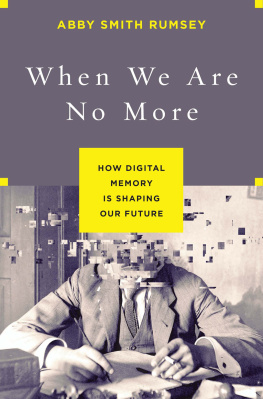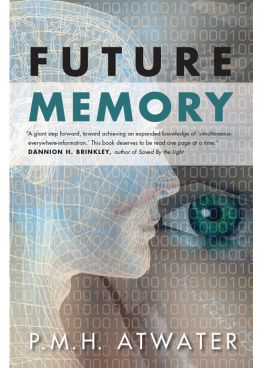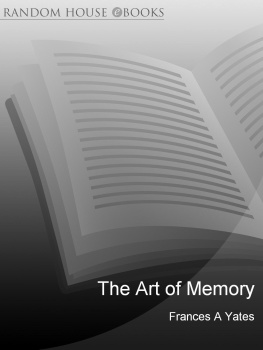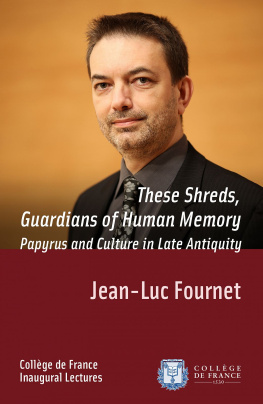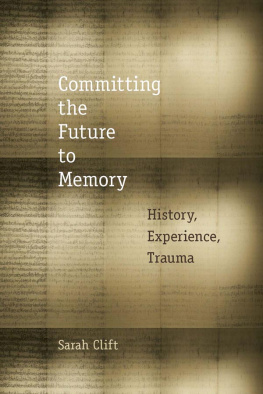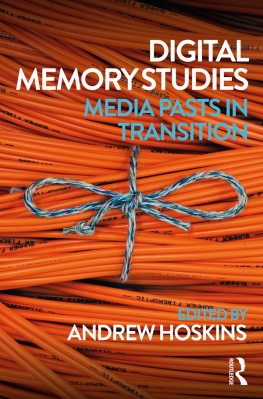for
David Rumsey
Hero of Time and Space

C ONTENTS
I imagine the earth when I am no more:
Nothing happens, no loss, its still a strange pageant,
Womens dresses, dewy lilacs, a song in the valley.
Yet the books will be there on the shelves, well born,
Derived from people, but also from radiance, heights.
CZESLAW MILOSZ , AND YET THE BOOKS , 1986
Over forty thousand years ago, humans discovered how to cheat death. They transferred their thoughts, feelings, dreams, fears, and hopes to physical materials that did not die. They painted on the walls of caves, carved animal bones, and sculpted stones that carried their mental and spiritual lives into the future. Over generations we have created sophisticated technologies for outsourcing the contents of our minds to ever more durable, compact, and portable objects. Each breakthrough in recording technology, from the creation of clay tablets six thousand years ago to the invention of papyrus scrolls, printing, photography, audio recording, and now ultracompact, portable, and extremely fragile digital media, has added to the vast stores of knowledge that hold the key to our success as a species. In the digital age we are dramatically expanding our capacity to record information, freeing us to pursue our curiosity at will and seek answers to ever more ambitious questions.
But every once in a while, we outsmart ourselves, and we have to scramble to catch up with our inventions. This is such a moment. The carrying capacity of our memory systems is falling dramatically behind our capacity to generate information. Since the creation of the World Wide Web in the 1990s and the growth of social media in the last decade, we feel increasingly overwhelmed by information. At the same time, we are intriguedif not downright infatuatedwith the power and promise of this abundance. We demand more and moreBig and Bigger Data. Yet it seems the more information we have, the less we feel in control of what we know. How do we catch up with ourselves now?
This is not the first time humanity has felt overwhelmed by the riches created by our ingenious inventions. Every innovation in information technology, going back to ancient Mesopotamians invention of cuneiform tablets, precipitates a period of overproduction, an information inflation that overpowers our ability to manage what we produce. Having more knowledge than we know what to do with while still eager to acquire more is simply part of the human condition, a product of our native curiosity.
But this moment is different in quality as well as quantity. We can no longer rely on the skills we have honed over millennia to manage our knowledge by managing physical objects, be they papyrus scrolls or paperback books. Instead, we must learn to master electrical grids, computer code, and the massive machines that create, store, and read our memory for us. What this mastery looks like and how we achieve it is todays frontier of knowledge.
The digital landscape before us is largely unmapped, terra incognita that we can only know by entering into it and exploring. Fortunately, vast as the unknown territory may be, digital technology itself helps speed communication of new knowledge between those rushing ahead to explore the unknown and those traveling at a slower pace who are settling the new landscape and making it productive. As the frontier retreats quickly before us, we can already see that our age-old understanding of humanitys collective memory as something fixed to durable objects and constrained by the limits of time and space is obsolete. Digital memory is ubiquitous yet unimaginably fragile, limitless in scope yet inherently unstable. Mastery of digital memory means grappling with its vulnerabilities as well as developing its strengths. We will explore both as we examine the future of memory in the digital age.
The consequences of going digital for the future of human memory came into sharp focus for me in 1997, while leading a team of curators at the Library of Congress to assemble a comprehensive exhibition of its collections for the first time in living memory. The library had just acquired its one hundred millionth item. From this abundance we were to select several hundred items that would tell the two-hundred-year story of the Library of Congress and, by extension, the American people. We had muchtoo muchto choose from. Home to the United States Copyright Office and faithful to its founder Thomas Jeffersons vision of creating a universal and comprehensive collection of human knowledge, the library has records in virtually every medium capable of carrying information, from rice paper and palm leaves to mimeographed sheets and onionskin paper, whalebones and deer hides, audio wax cylinders, early television kinescopes, silent movies on nitrate film, maps on vellum, photographic negatives on glass plates the size of tabletopsand, of course, computer code on tape, floppy disks, and hard drives.
It was remarkably easy to select several hundred objects out of one hundred million because each object tells a tale. To tell the story of how the Republic was born, for example, we displayed the Rough Draft of the Declaration of Independence, crafted over a few days in July 1776 by Thomas Jefferson and edited by Benjamin Franklin, John Adams, Roger Sherman, and Robert Livingston. It is written in the eminently legible hand of Thomas Jefferson. Yet several passages are boldly struck through with lines of heavy black ink and emended with the changes made by Adams and Franklin.
The sight of Jeffersons venerated text so vividly edited always draws people up short. They are startled to see that the most famous phrase in this most famous documentwe hold these truths to be self-evident, that all men are created equalis not what Jefferson wrote. He wrote that the truths are sacred and undeniable. The words we know so well today are in fact a correction suggested by Benjamin Franklin. The jarring yet oddly familiar sight of the Declaration of Independence in full Track Changes mode makes self-evident the disagreements among the Founders and the compromises they agreed on. The original document renders the past strangely newthe events dramatic, the motives of the actors complicated, the conclusion unpredictable.
Historians continue to mine the Rough Drafts four pages of tangible evidence for clues to the early stages of the colonial rebellion. As a historian, I was familiar with the excitement of working with original documents. I also knew how stirringat times emotionalit is to work directly with originals. A physical connection between the present and past is wondrously forged through the medium of time-stained paper. Yet what I remember most vividly is the impact of the Rough Draft on tourists. Many of the visitors had stopped by the library simply as one more station on a whirlwind circuit of the capital. They were often tired and hot and not keen on history in the best of circumstances. But this was different. They would grow quiet as they approached the exhibit case. They lowered their heads toward the glass, focused on lines of text struck through to make out the words scribbled between lines, and began to grasp what they were looking at. Their reactions were visceral. Even dimly lit and safely encased in bulletproof glass, the Rough Draft emanates an aura of the sacred and undeniable.
It was then that I started to think seriously about the future of memory in the digital agethough worry is the more accurate word. What would my successor show in two hundred years timeor even fifty years? How would people feel that distinctive visceral connection with people from the past if the past had no undeniable physical presence? What we displayed in 1997 had withstood the test of time. It was already self-evident that there would be no test of time for digital information. At that time, web pages lasted an average of forty-four days before changing or disappearing altogether. We seemed to be moving at breakneck speed from a knowledge economy of relative scarcity of output to one of limitless abundance. By latest count in 2015, the Library of Congress had well over 160 million items, already a startling increase over the 100 million it counted in 1997. But relative to what circulates on the web, its collections could be described as if not scarce at least tractable. Engineers at work on building the largest radio telescope in the world, the Square Kilometre Array, estimate that when the telescope is up and running, it will produce up to one exabyte (1018 bytes) of data per day, roughly the amount handled by the entire Internet in 2000. And the web itself grows inexorably. One data-storage company estimates that worldwide, web data are growing at a rate that jumped from 2.7 billion terabytes in 2012 to 8 billion terabytes in 2015. But nobody really knowsor even agrees how we should be counting bits.
Next page
